FOREST TALES
A conversation with the man who paints trees to combat bark stripping
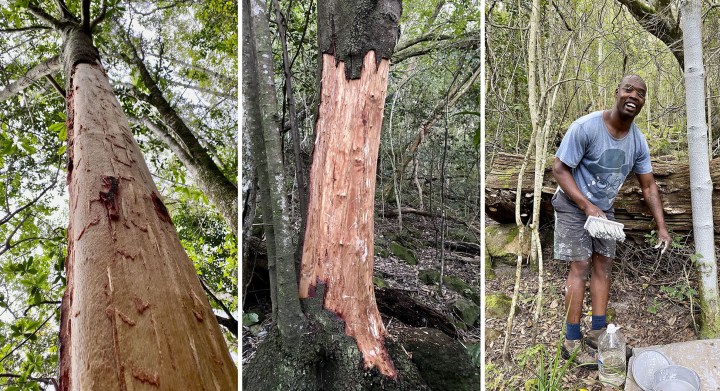
In Newlands Forest on the slopes of Devil’s Peak you may notice trees with unobtrusive grey bark part of the way up. Enquiries led to a man who paints them.
Willem Boshoff is sitting under a turkey berry tree. He’s a tall man with a slightly greying beard, easy warmth and an infectious laugh. He loves this forest. As we talk, there’s the smell of brewing tea, which makes sense given all the tannin rotting on the forest floor.
Behind him is a massive wild almond, its multiple trunks flung wide like a giant octopus. The ground is a yellow carpet of fallen leaves and the living leaves above are filled with the chuck and chatter of birds living their perfect lives.
Earlier, as we walked uphill through Newlands Forest on the slopes of Devil’s Peak in Cape Town, however, bark stripping had exposed ugly scabs and raw wood. Some trees were entirely ring-barked, others dead and fallen.
“There’s so much environmental damage in the world,” Boshoff says. “It feels good to be able to be here helping this forest to survive.” When he walked into the forest in 2019 that seemed unlikely, he explained in an interview.
***
Willem Boshoff: In the ravine up near the Contour Path, beautiful, lush, big, old trees had been growing for centuries and it looked like a herd of elephants had gone through. Dead and fallen trees all over the show. Rips in the canopy.
I didn’t know what was going on. I thought SANParks was killing bad trees. Then I met a ranger and he said it was illegal bark stripping.
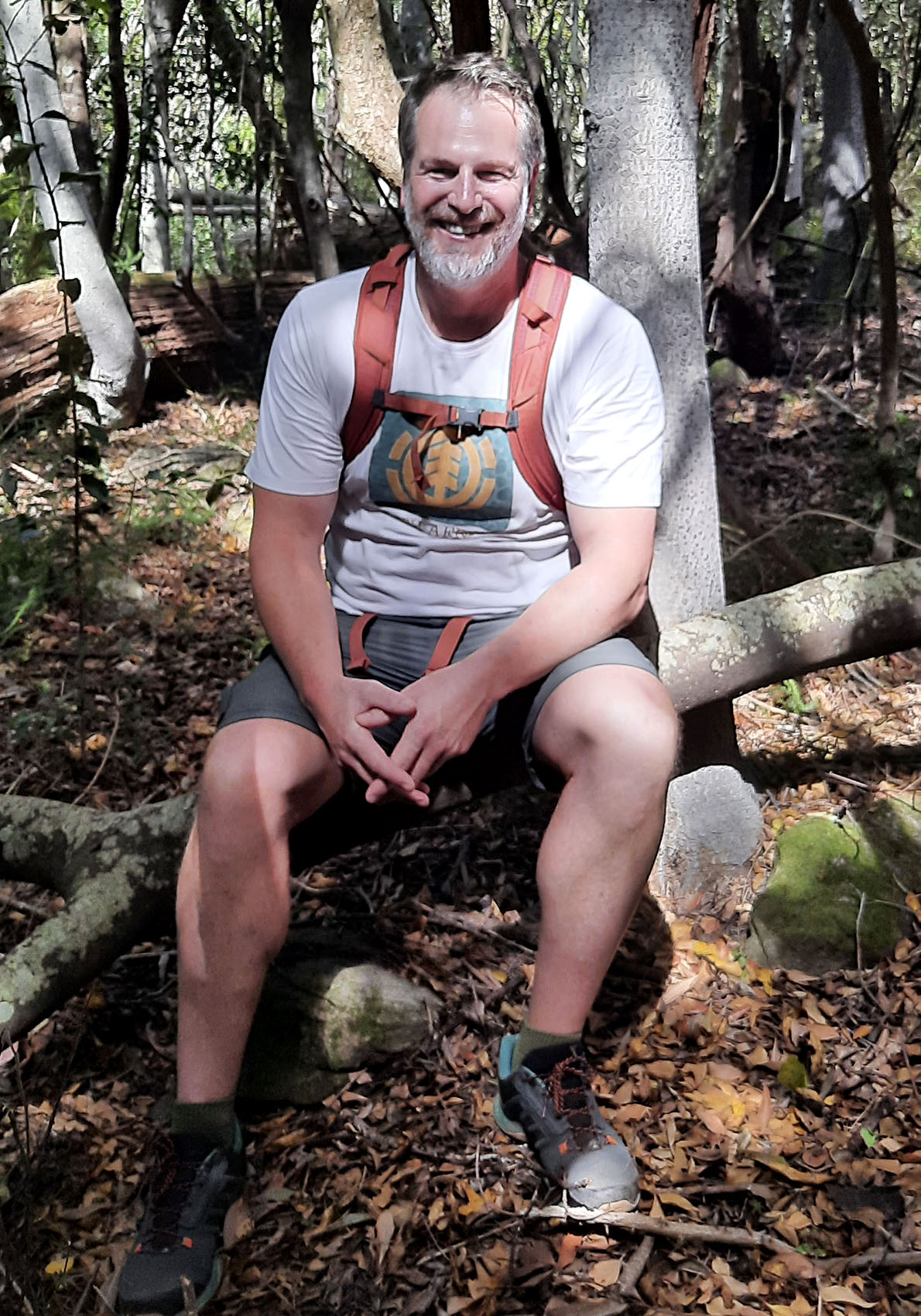
Willem Boshoff under a tree. (Photo: Don Pinnock)
Newlands was evidently under so much strain from stripping that some areas of the forest had crossed a tipping point. It really affected me. My poor wife had to deal with me walking around in the forest at 10 o’clock at night with my little head torch and pepper spray to catch these guys.
Don Pinnock: And did you?
WB: Never, never. The guys are extremely brazen but they know the terrain. Once you’re in the forest, it’s very hard for anybody to see you. Bark is literally low-hanging fruit, very easy to strip and get away with it. During Covid, there was an absolute explosion of stripping.
I started googling and found some articles about the phenomenon. I was like: Wow this is really bad. I’m seeing mature trees being bark-stripped, protected species like assegai … Cape beech, Cape hollies. I started posting on social media about it, saying this seems to be a big problem and is anybody doing anything about it?
A guy called Neil Williamson contacted me and said he’s seeing the same thing. Next thing we had a website up and the Newlands Forest Conservation group was born. Some people were asking, what can we do? Some were suggesting drones or tripwires.
We heard that some arborists had success preventing bark stripping in urban areas by painting trees. So we painted some Cape beech trees in the area guys were actively stripping to see what would happen. We used weak, grey PVA, it’s not too intrusive. Then we observed the site for a few months. People were stripping all around it but not the painted trees. We’d found a solution.
DP: There are a lot of trees in Newlands Forest…
WB: Yeah, well we had a problem of scale, of course. It took me a whole afternoon to paint eight trees. I had been doing hacking — that’s eradicating invasive alien plants — in my spare time and explained my problem to Sandy van Hoogstraten of the Sugarbird Trust, an alien plant removal PBO, and she asked: “How much money do you need to paint the forest?” Suddenly we had the budget to put a permanent team together.
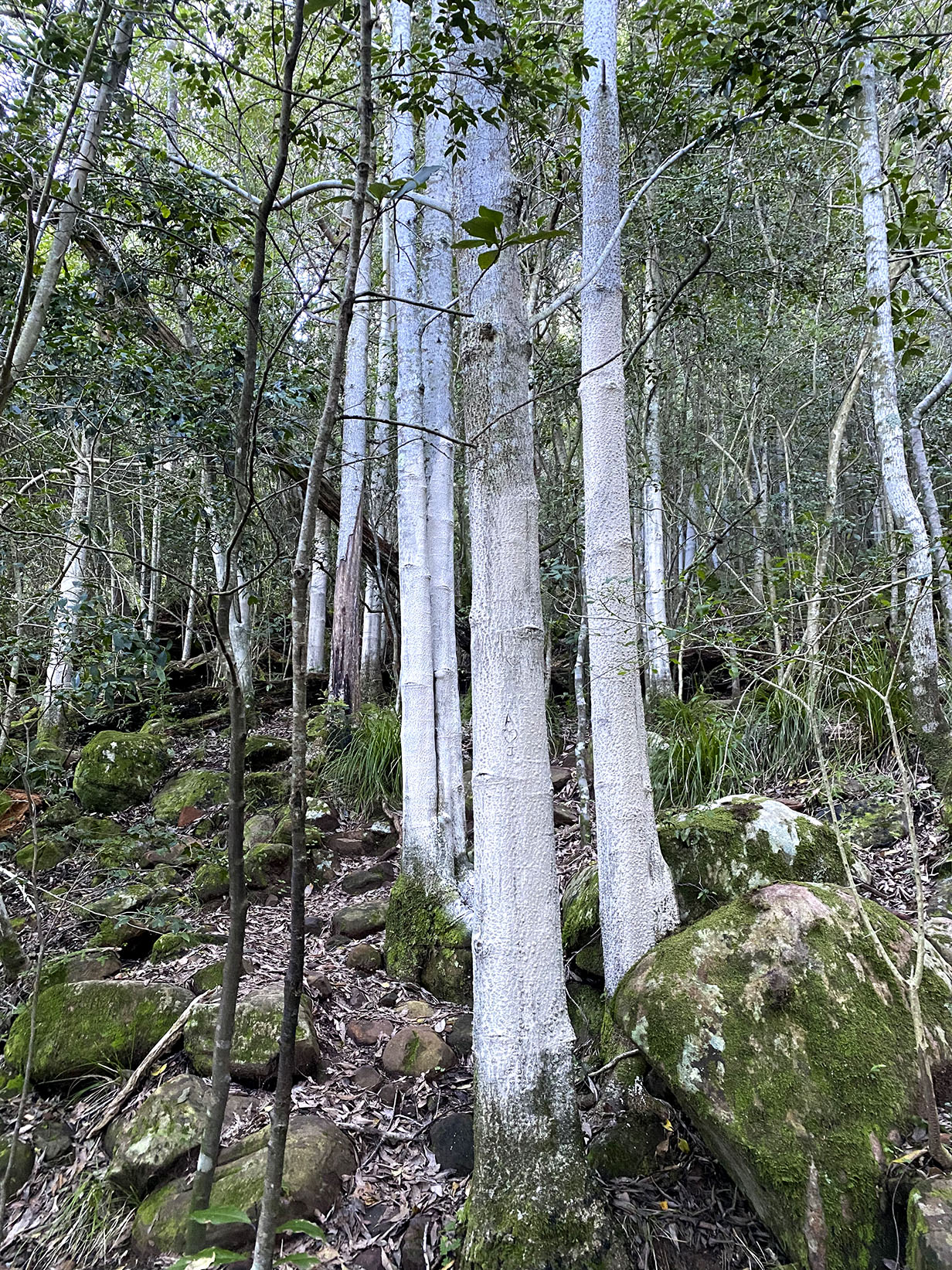
Trees painted with PVA are unobtrusive. (Photo: Willem Boshoff)
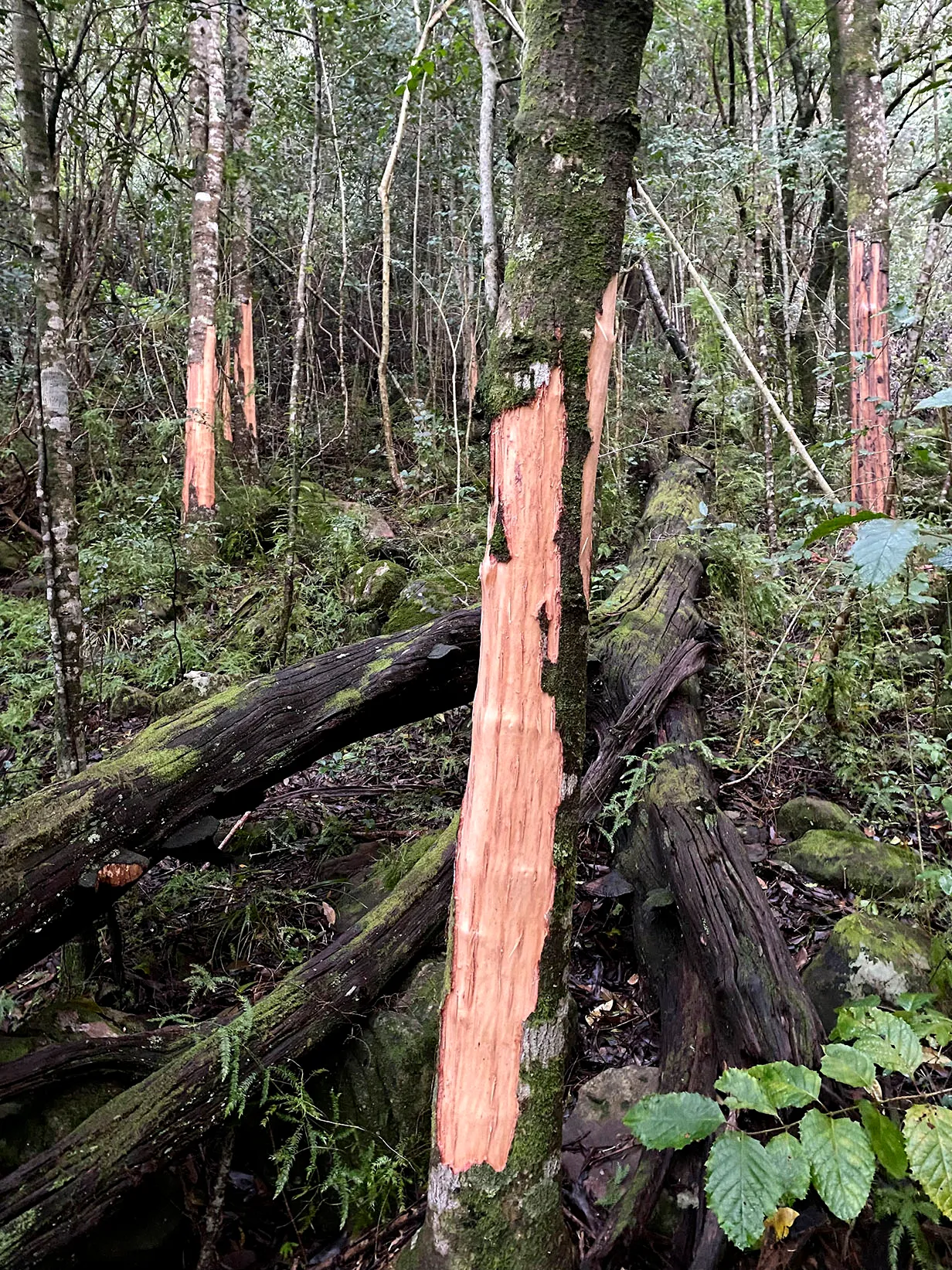
Tree strippers come by night and leave destruction. (Photo: Willem Boshoff)
We experimented with different techniques — spray on, paint on, how to reduce splatter, different levels of dilution — and over time we found the best methodology.
DP: So, how many trees have you painted?
WB: Over six months we painted about 3,000 but lost count because the team was working so quickly. We started with mature specimens. I mean, if you shoot a mature rhino, in six years you’ve got a mature rhino again. If you ring-bark a 150-year-old assegai tree, there’s a 150-year hole in that forest. The loss of those old trees was so grievous to me and we’d lost hundreds of them.
Since we’ve painted the remaining ones, none of them have been stripped. Old trees form the bulk of the forest canopy and they seed and regenerate the forest. Then we looked at the smaller trees and decided to preserve 10-, 20-, 30-year olds as well.
DP: Which trees are being targeted by strippers?
WB: Cape beech, Cape holly, assegai, stinkwood and sometimes wild peach, red alders, hard pear and a few others. There are very few stinkwoods left.
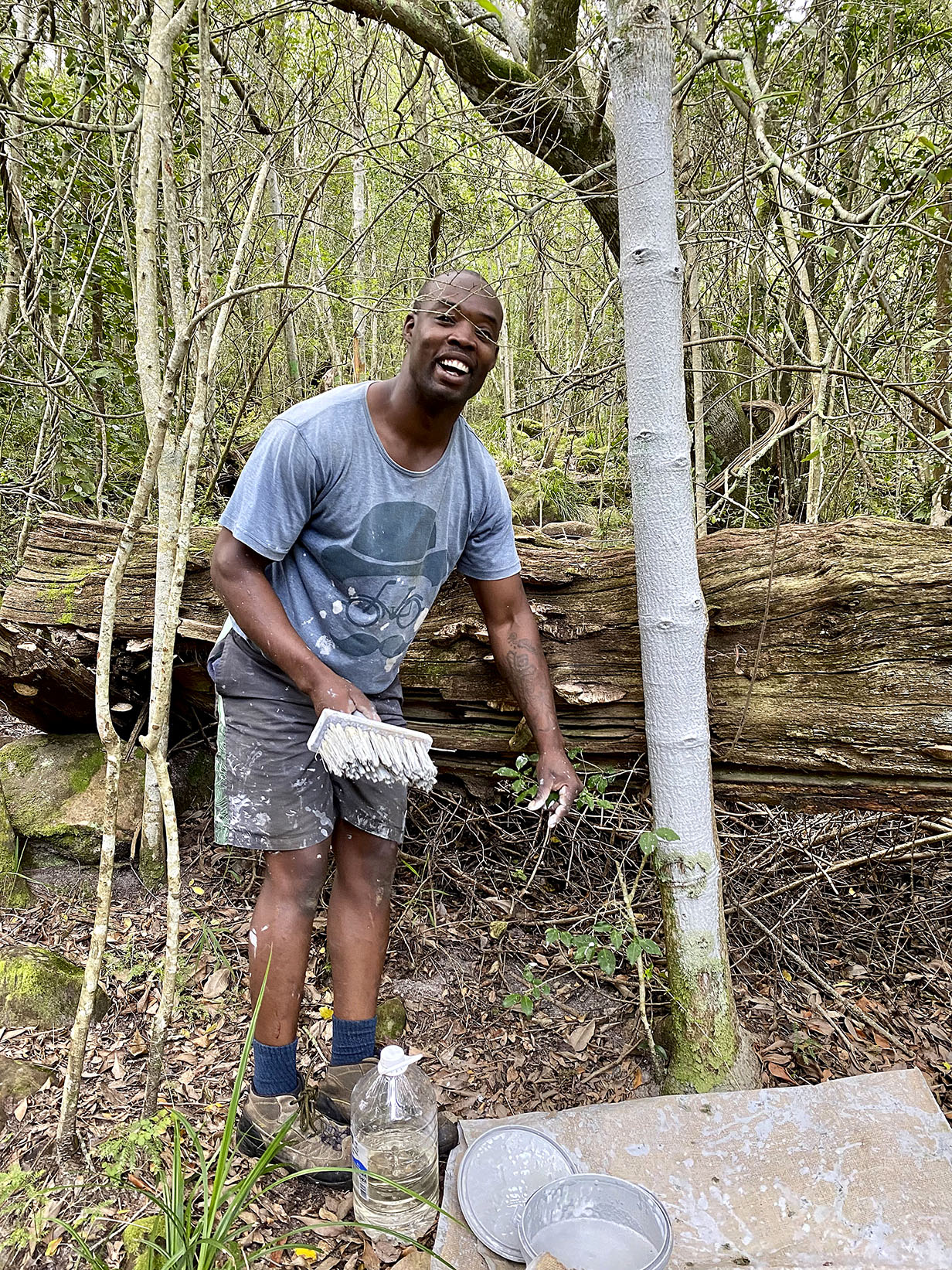
Tree painter Alex Murahla at work. (Photo: Willem Boshoff)
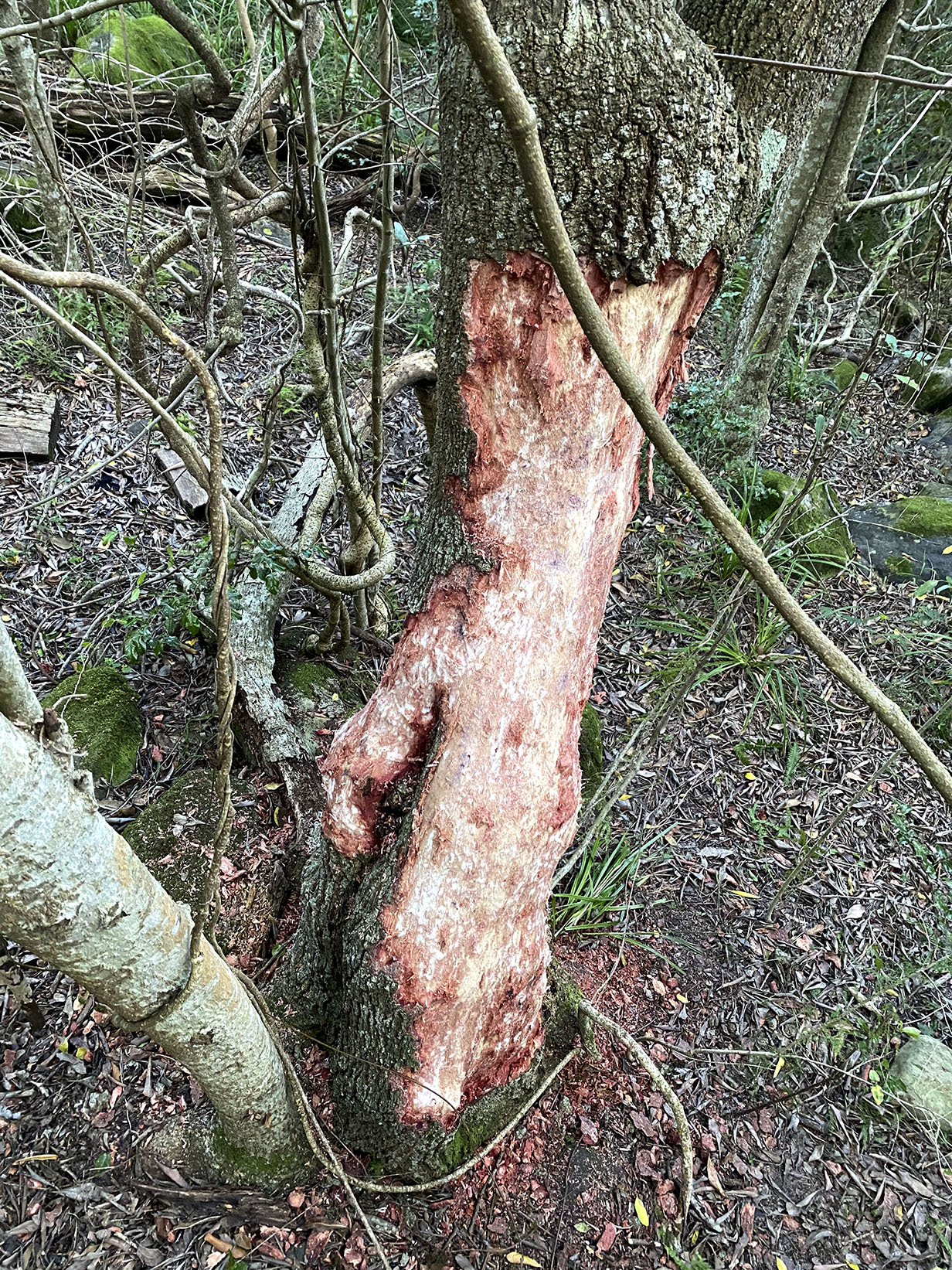
The death knell of a tree. (Photo: Willem Boshoff)
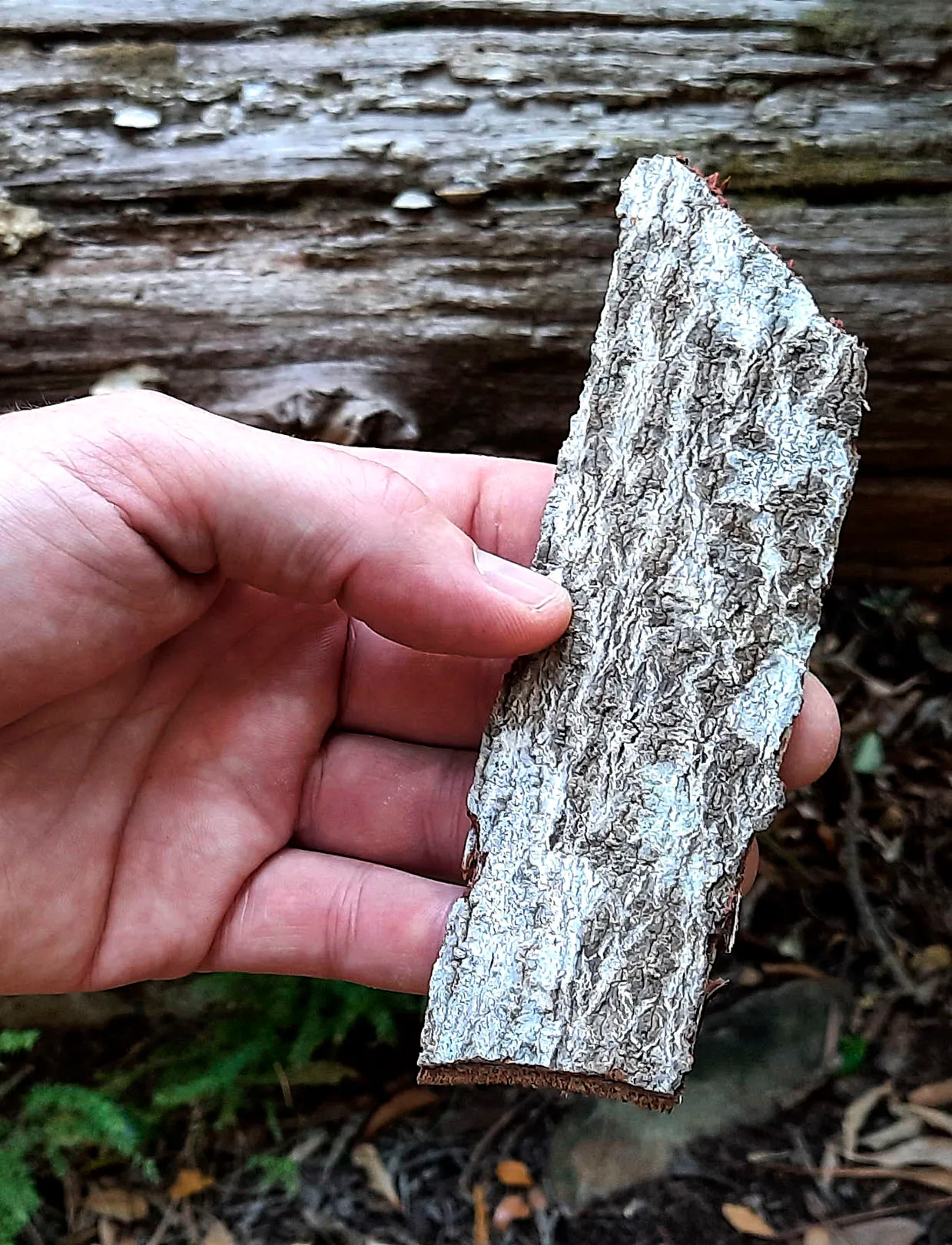
The beginning of the end of a tree. (Photo: Don Pinnock)
Sensitive terrain
DP: Is there any medicinal value in the bark?
WB: There is some value, but the efficacy is considerably lower than common medicines you can buy in a pharmacy. There are two dynamics involved. One is access to traditional medicine that may be cheaper, the other is traditional beliefs.
Becoming critical of a cultural practice is very sensitive terrain. We’re not critical of a practice that has been going on for centuries, we are critical about it being done in a completely unsustainable manner, and then going from unsustainable to extremely destructive. For some, it’s simply a commercial criminal enterprise.
DP: Why does the paint work so effectively?
WB: The [bark] strippers aren’t sure what’s in the paint. Could it kill you or make you sick? They don’t necessarily know. And the guys who buy it from them and their customers are not going to trust painted bark.
The project has been an enormous success. Not a single tree we’ve painted has been stripped. We went from bark stripping being the number one threat to Newlands Forest to it currently hardly being a threat at all.
DP: What is Table Mountain National Park doing about it?
WB: SANParks do what they can, but the park is very difficult to police. You’ve got a metropole with 4.5 million people around this little indigenous forest. There’s no fence. In it is a product that a large part of that population wants. And when Parks find the guys and they get charged, they often don’t get prosecuted because it’s considered such a low-level crime. Where does it sit in relation to murder and rape?
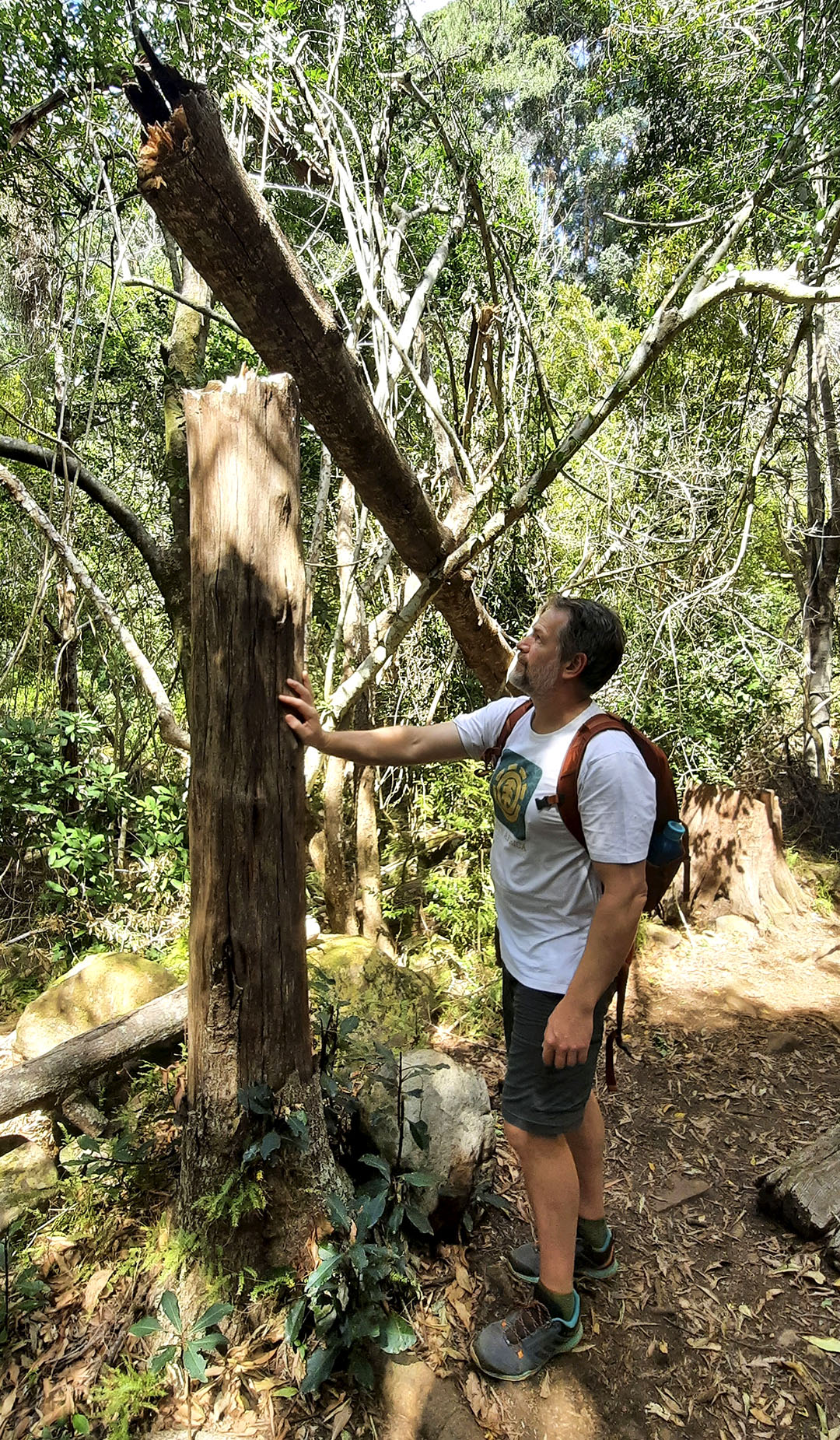
Willem Boshoff says stripped trees die and are easily blown over. (Photo: Don Pinnock)
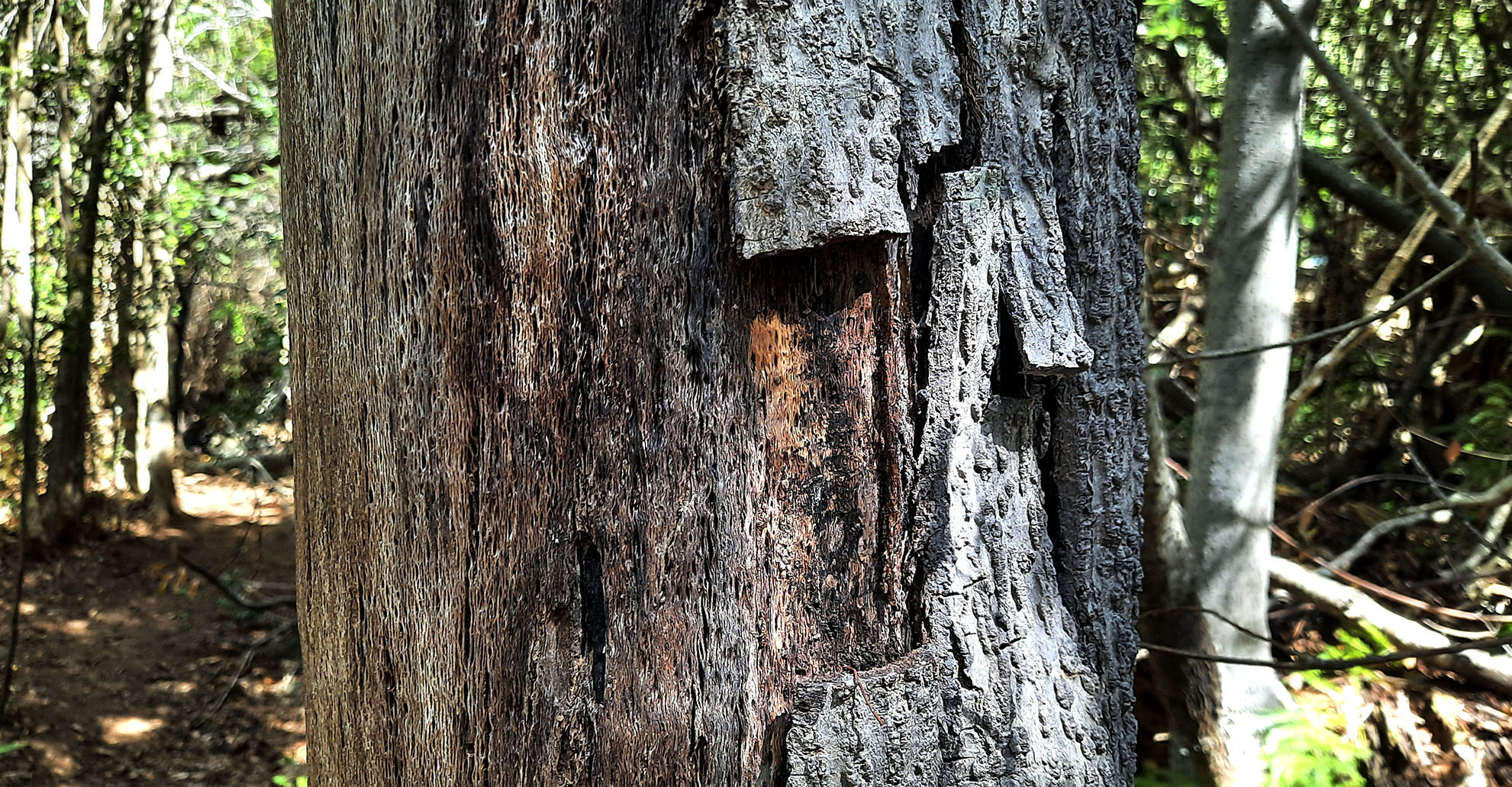
Stripped trees cannot survive. (Photo: Don Pinnock)
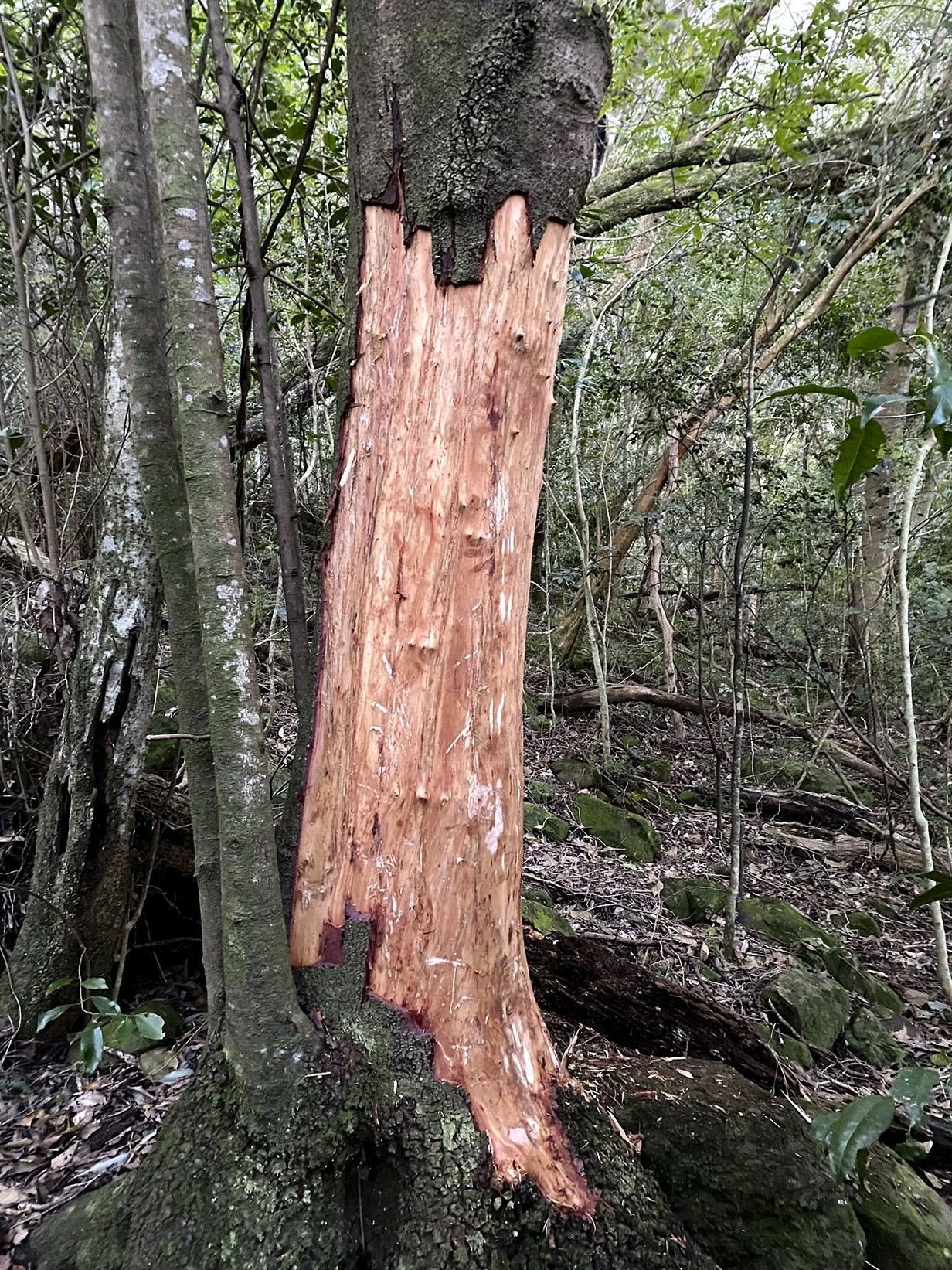
Stripped for the market and left to die. (Photo: Willem Boshoff)
I’d like to see the money generated by Table Mountain National Park employed more efficiently. Some park rangers really go the extra mile and I’d like to see them well funded. At the same time, the park is enjoyed by thousands of citizens every week. There’s almost an entitlement that goes with that.
I don’t want to step on people’s toes, but I think public interest organisations need to step up and the public need to recognise that we have a responsibility. As users, we need to contribute to the park’s upkeep.
Of course, there are those who do. The Sugarbird Trust has little signs on the mountain with a Snapscan code and somebody contributed R50,000 the other day. And look at the amazing work that Friends of Table Mountain or Take Back Our Mountains does. Friends spent half a million rand last year repairing trails and this year we hope to do double or triple that amount — all public funding.
DP: Do you have a favourite tree?
WB: I have a soft spot for assegai, but also stinkwoods. Actually, I love the red alder as well, they’re beautiful. But, you know, the ecosystem as a whole is a beautiful thing. It’s not just about individual trees.

Stripped and dying. (Photo: Willem Boshoff)
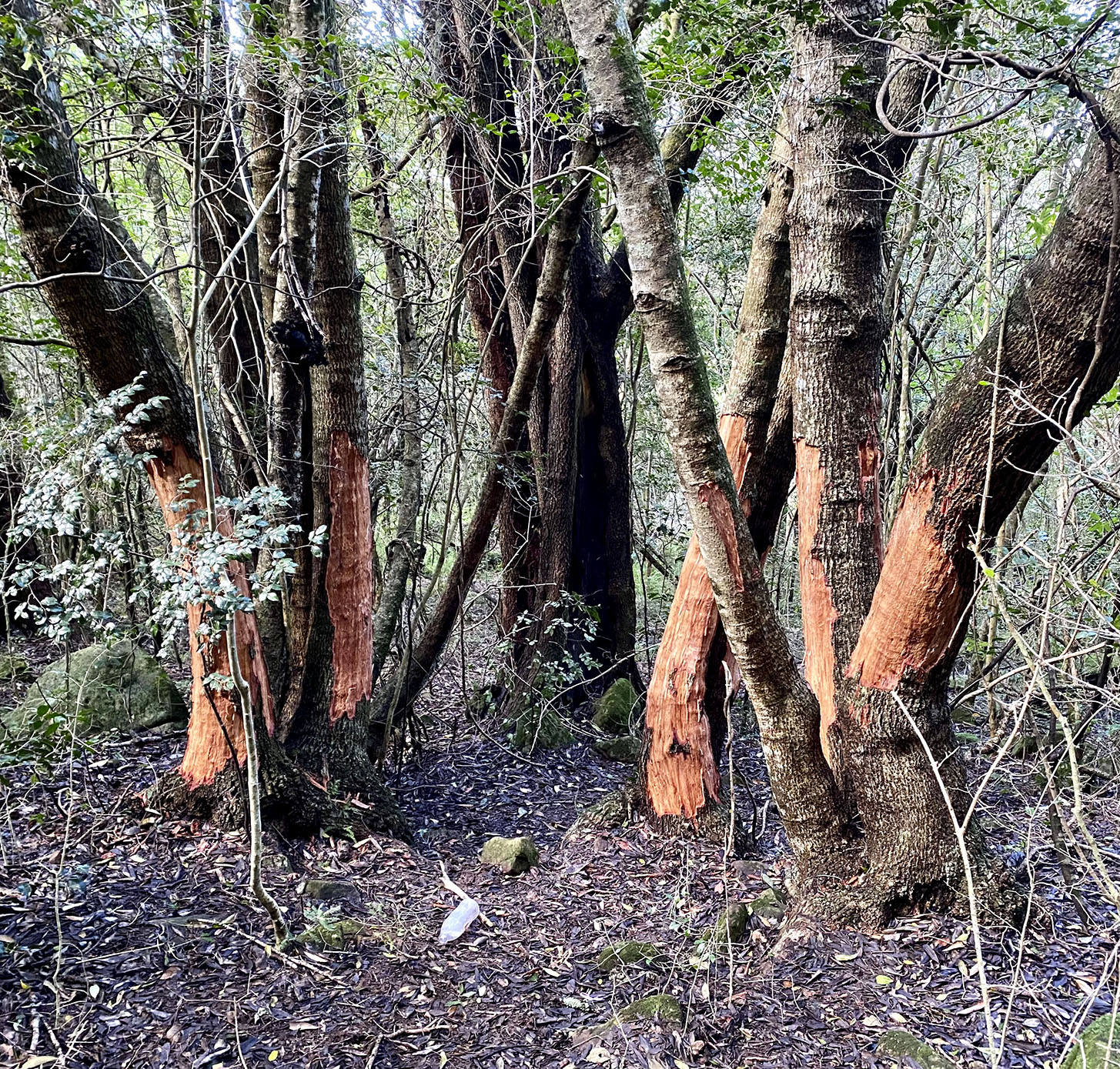
Stripped for the market and left to die. (Photo: Willem Boshoff)
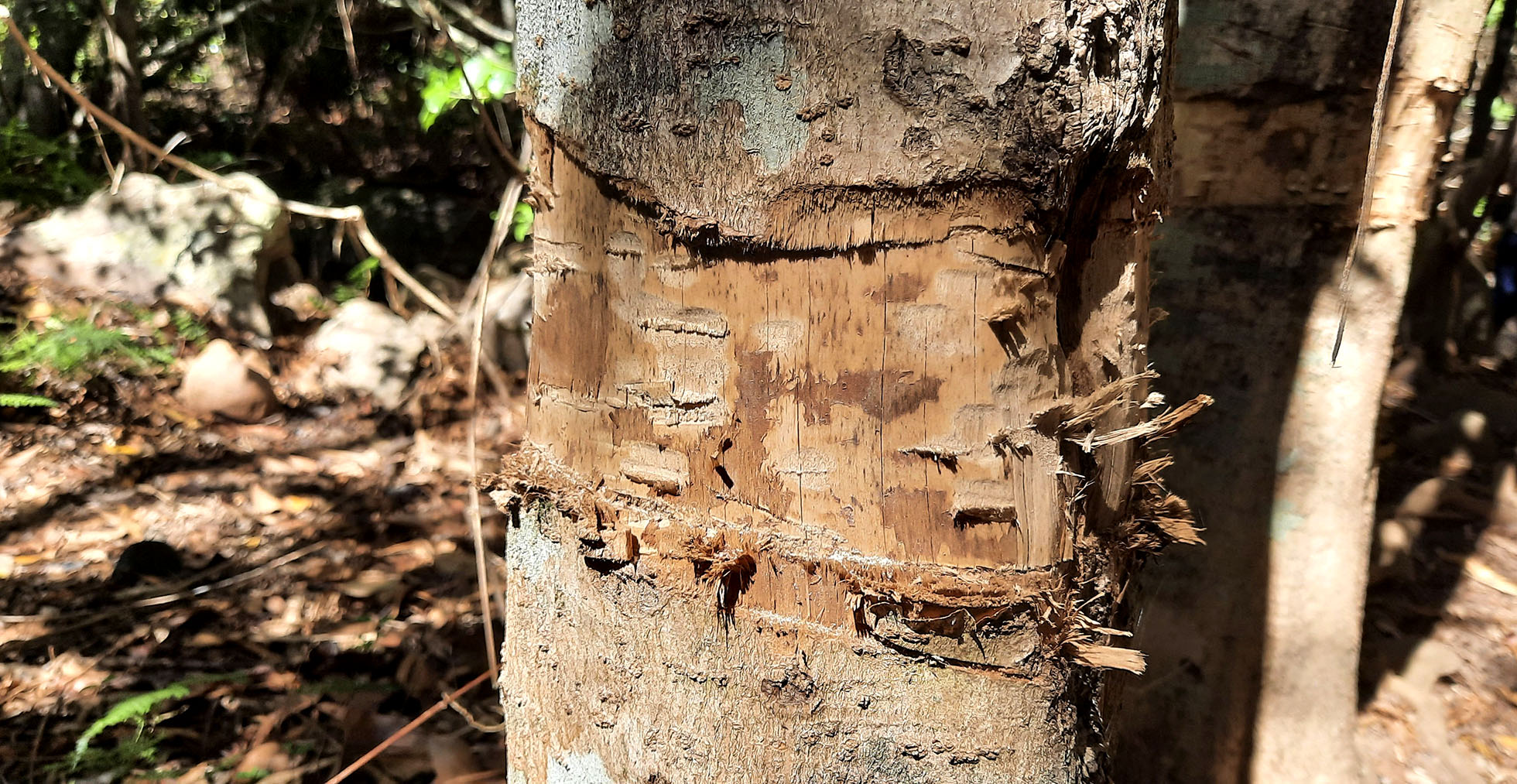
Ring barking is a sure death sentence. (Photo: Don Pinnock)
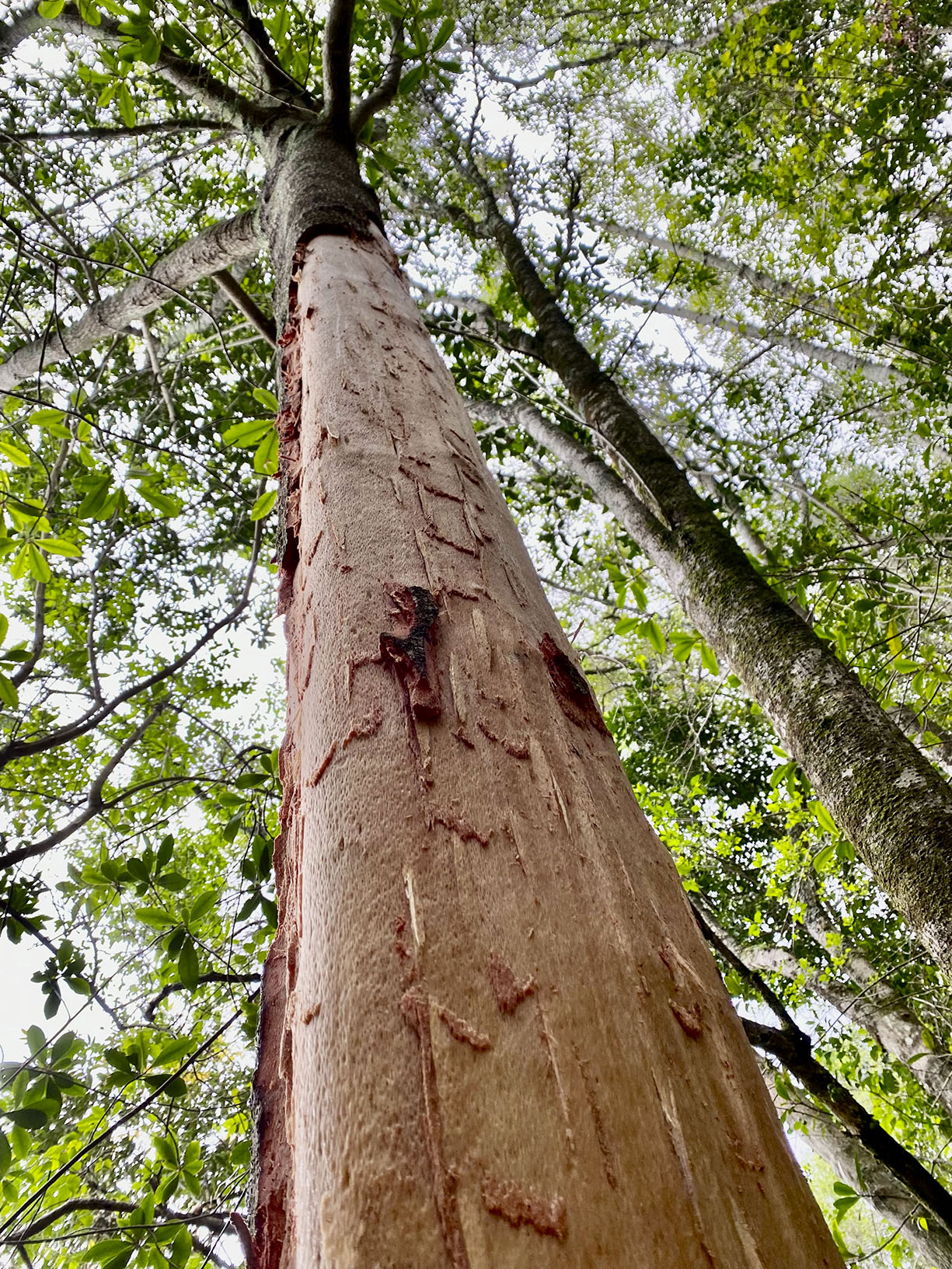
Hacked and dying. (Photo: Willem Boshoff)
***
Boshoff is an actuary who spends more time on Excel spreadsheets than among trees. He has meetings up ahead and needs to go. He leads the way down along the deeply-incised Newlands River, sidestepping hurtling, happy dogs and their owners. He pats a large tree beside the path.
“Wild almond,” he says, “a descendent of Jan van Riebeek’s original hedge, maybe.”
It’s hard work caring for a forest, I say, just before we part ways. Why do you do it?
“I guess I care. I want future generations to be able to enjoy this place. I would love my daughters to be able to walk into Newlands Forest one day, look up at a 200-year-old indigenous tree and marvel at its beauty. I think it’s worth protecting.” DM




















 Become an Insider
Become an Insider
is there maybe something that can be wrapped around the ring barked tree so it can survive and regrow the bark?
There is, but it would be more costly and time consuming than painting:
Place any bark that is still attached back in the wound, and pack it with sphagnum moss wrapping the area with hessian tape.
Thanks – would the bark grow back over time?
In an enclosed private graveyard in Wynberg, Cape Town, over a period of about five years, about 10 relatively old trees have now been completely stripped of their bark. The huge trees are now all dead, and with time, will all fall over. All for muti.
Complete removal of a bark depicts a warped mentality that death of a tree bestows supernatural powers(not scientific but a belief)unto the muti. Cancelation of apartheid rangers with arresting powers and cooperation with chiefs has resulted into wholesale deforestation even of pristine riverside tall trees with bird life. That plus proliferation of uncontrolled use of chainsaws for commercial firewood. Chainsaws in the hands of nyaope addicts too low for environmental minister to know about. Chiefs are no longer environmental custodians and most spend bulk of their times attending endless council meetings administered by goldtooth politicians. Sad.
Until sustainability snd conservation are recognised as an economic cornerstone, the environment will continue to be abused snd destroyed by humans. Insanity. I despair that the next generation and the next are just interested in instant gratification on social media paying no attention to the natural world around us, until it will be too late.
Admirable work, thanks 😊
Hiking is a great pasttime for us as a family, but haven’t noticed much in the areas that I have been in eg underberg, hogsback, but I haven’t been in the Capetown metro recently.
But are we sure that we are not creating a new problem for the ecosystem with the painting 🤔
Can we not try to really understand the debarking problem such that we can create a solution that will keep both sides happy with still having a healthy forest?
Kind regards
Thanks for the comment. There’s unfortunately no way to harvest bark sustainably from a tree’s trunk. They either die or their growth is permanently stunted. Some studies suggest the medical efficacy of leaves and twigs is far higher than that of bark (which has a low concentration of the beneficial elements); that is our best shot at sustainable, long-term harvesting for traditional use, but will require a monumental education effort to change the current practice. The painting is a short to medium-term intervention to stop the destruction of the forest. To our knowledge (after getting several expert opinions) the paint has minimal environmental impact.
A huge Thank you! to you, your team, and all your supporters.
“This, however, is not so surprising in them; for no one is so old that he does not expect to live a year longer. But the same persons bestow great pains in labor from which they know that they shall never derive any benefit. …
Nor, indeed can the farmer, though he be an old man, if asked for whom he is planting, hesitate to answer, ‘For the immortal gods, whose will it was, not only that I should receive this estate from my ancestors, but that I should also transmit it in undiminished value to my posterity.'” – Cicero
Great work Willem and team. However I am sad to report that I saw painted trees on the Woodcutters trail this morning that had been aggressively stripped.
Thank you, Willem, for spending your time WELL and to Don, for sharing this account.
Trees are priority. Would be glad to support in any way useful.